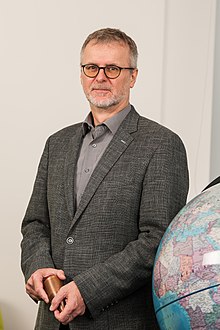Stephan Borrmann
Stephan Borrmann (born January 18, 1959 in Mainz ) is a German meteorologist . Since 2000 he has been working as a professor at the Institute for Atmospheric Physics at Johannes Gutenberg University Mainz. He has also been Director and Scientific Member at the Max Planck Institute for Chemistry (MPIC) in Mainz since 2001 .
biography
From 1977 to 1984 he studied physics and biology at the Johannes Gutenberg University in Mainz . After completing his studies, he spent two years as an Adjunct Research Instructor at the Naval Postgraduate School in Monterey / CA / USA. After returning to Mainz he completed his doctorate in 1991 in physics with a focus on experimental meteorology. He then worked for two years until 1993 as a postdoctoral fellow of the Advanced Study Program of the University Corporation of Atmospheric Research (UCAR) at the National Center for Atmospheric Research (NCAR) in Boulder / CO / USA. While Stephan Borrmann was head of the research group for aerosols at the Institute for Chemistry and Dynamics of the Geosphere at Forschungszentrum Jülich GmbH from 1998 to 2000 , he completed his habilitation in the field of meteorology in 1999.
In 2001 Stephan Borrmann became director and scientific member of the Max Planck Institute for Chemistry (MPIC) in Mainz, having previously been appointed professor for "Experimental and Observational Meteorology" in the physics department at Johannes Gutenberg University in Mainz in October 2000. Since then, he has headed the Department of Cloud Physics and Chemistry, which was newly founded when he joined the MPIC and established together with the University of Mainz, which was renamed the Department of Particle Chemistry in 2005.
In 2012, Borrmann received an ERC Advanced Grant of 2.75 million euros from the European Research Council (ERC).
research
The research activities of the Particle Chemistry Department of the Max Planck Institute for Chemistry serve to investigate physical and chemical processes in clouds and aerosols. A special focus here are the ice clouds in the border region between the troposphere and the stratosphere , as well as the polar stratospheric clouds, which are significantly involved in ozone depletion. Aircraft-borne measurement techniques are used, in which individual aerosol or cloud particles are vaporized thermally or with an intense laser flash in order to analyze the resulting ion cloud by mass spectrometry with regard to its chemical composition. These and a variety of other methods are also used on the ground on ships, mountain stations and in a mobile laboratory to characterize the chemistry of particles from emissions from individual sources (such as ships, steelworks, waste incineration, industrial plants) as well as in urban air pollution and smog. With the help of NanoSIMS technology, individual particles of the meteorite dust and cometary material are chemically analyzed in order to obtain information about the processes involved in the formation of the solar system. In the worldwide unique vertical wind tunnel laboratory, physical and chemical tests are carried out on cloud and raindrops, ice particles, snowflakes, sleet and hail. These serve the basic understanding of cloud processes (e.g. frost and hail formation) and its implementation in models for precipitation forecast, weather forecast and climate.
literature
- Max Planck Society: Manual of Scientific Members, Munich 2006
Web links
- https://www.mpic.de/3784114/borrmann-profile
- http://www.mpg.de/443699/chemie_wissM1
- https://www.ipa.uni-mainz.de/professoren/
Individual evidence
- ↑ EUR 2.75 million EU grant for cloud researcher Stephan Borrmann at Informationsdienst Wissenschaft (idw-online.de); accessed on October 31, 2012
| personal data | |
|---|---|
| SURNAME | Borrmann, Stephan |
| BRIEF DESCRIPTION | German meteorologist |
| DATE OF BIRTH | January 18, 1959 |
| PLACE OF BIRTH | Mainz |
